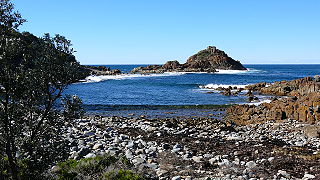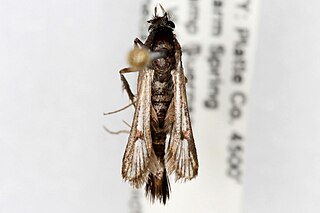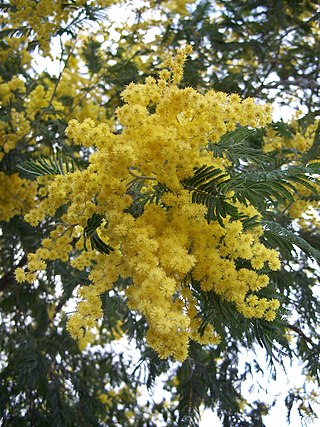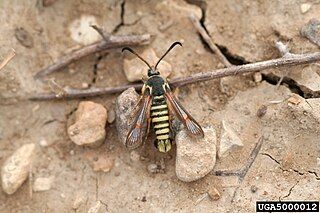
Mimosa is a genus of about 600 species of herbs and shrubs, in the mimosoid clade of the legume family Fabaceae. Species are native to the Americas, from North Dakota to northern Argentina, and to eastern Africa as well as the Indian subcontinent and Indochina. The generic name is derived from the Greek word μῖμος (mimos), an "actor" or "mime", and the feminine suffix -osa, "resembling", suggesting its 'sensitive leaves' which seem to 'mimic conscious life'.

In ancient Roman religion and myth, Carmenta was a goddess of childbirth and prophecy, associated with technological innovation as well as the protection of mothers and children and a patron of midwives. She was also said to have invented the Latin alphabet.

Mimosa Rocks is a national park in New South Wales, Australia, 329 km southwest of Sydney near the towns of Tathra and Bermagui. The park is close to Bournda National Park and forms part of the Ulladulla to Merimbula Important Bird Area, identified as such by BirdLife International because of its importance for swift parrots.

Mimosa is the second-brightest object in the southern constellation of Crux, and the 20th-brightest star in the night sky. It has the Bayer designation β Crucis, which is Latinised to Beta Crucis and abbreviated Beta Cru or β Cru. Mimosa forms part of the prominent asterism called the Southern Cross. It is a binary star or a possible triple star system.

Albizia is a genus of more than 160 species of mostly fast-growing subtropical and tropical trees and shrubs in the subfamily Mimosoideae of the family Fabaceae. The genus is pantropical, occurring in Asia, Africa, Madagascar, America and Australia, but mostly in the Old World tropics. In some locations, some species are considered weeds.

Carmenta is a genus of moths in the family Sesiidae.

Mimosa pudica is a creeping annual or perennial flowering plant of the pea/legume family Fabaceae. It is often grown for its curiosity value: the sensitive compound leaves quickly fold inward and droop when touched or shaken and re-open a few minutes later. For this reason, this species is commonly cited as an example of rapid plant movement. Like a number of other plant species, it undergoes changes in leaf orientation termed "sleep" or nyctinastic movement. The foliage closes during darkness and reopens in light. This was first studied by French scientist Jean-Jacques d'Ortous. In the UK it has gained the Royal Horticultural Society's Award of Garden Merit.

Mimosa pigra, commonly known as the giant sensitive tree, is a species of plant of the genus Mimosa, in the family Fabaceae.

Acacia dealbata, the silver wattle, blue wattle or mimosa, is a species of flowering plant in the legume family Fabaceae, native to southeastern Australia in New South Wales, Victoria, Tasmania, and the Australian Capital Territory, and widely introduced in Mediterranean, warm temperate, and highland tropical landscapes.

Albizia lebbeck is a species of plant in the family Fabaceae, native to the Indian subcontinent and Myanmar. It is widely cultivated and naturalised in other tropical and subtropical regions, including Australia. Common names in English include siris, Indian siris, East Indian walnut, Broome raintree, lebbeck, lebbek tree, frywood, koko and woman's tongue tree. The latter name is a play on the sound the seeds make as they rattle inside the pods. Siris is also a common name of the genus Albizia.

Mimosa diplotricha is a species of leguminous woody shrub native to the Neotropics. It is an invasive species and now has a pantropical distribution. It is commonly known as the giant sensitive plant, giant false sensitive plant, or nila grass.

Bormes-les-Mimosas is a commune in the Var department, Provence-Alpes-Côte d'Azur Region, southeastern France.

Carmenta mimuli, the coronopus borer, is a moth of the family Sesiidae. The dark form is the typical form and is found in Arizona. The whitish form is non-typical and is known from the south-western United States, from Kansas to Arizona.
Carmenta chromolaenae is a moth of the family Sesiidae. It is native to Venezuela, but was introduced to South Africa for the biological control of Siam weed.

In Australia, Mimosa pigra has been declared a noxious weed or given similar status under various weed or quarantine Acts. It has been ranked as the tenth most problematic weed and is listed on the Weeds of National Significance. It is currently restricted to the Northern Territory where it infests approximately 80,000 hectares of coastal floodplain.
Eois carmenta is a moth in the family Geometridae first described by Herbert Druce in 1892. It is found in Guatemala.

Mimosa salad is a festive salad, of which the main ingredients are cheese, eggs, canned fish, onion, and mayonnaise. Mimosa salad got its name because of its resemblance to mimosa flowers scattered on the snow. The similarity is achieved by crumbling and scattering boiled egg yolk on the surface. The salad's popularity in the USSR has led to the emergence of a wide variety of recipes.
Mimosa is a rural locality in the Central Highlands Region, Queensland, Australia. In the 2021 census, Mimosa had a population of 23 people.













